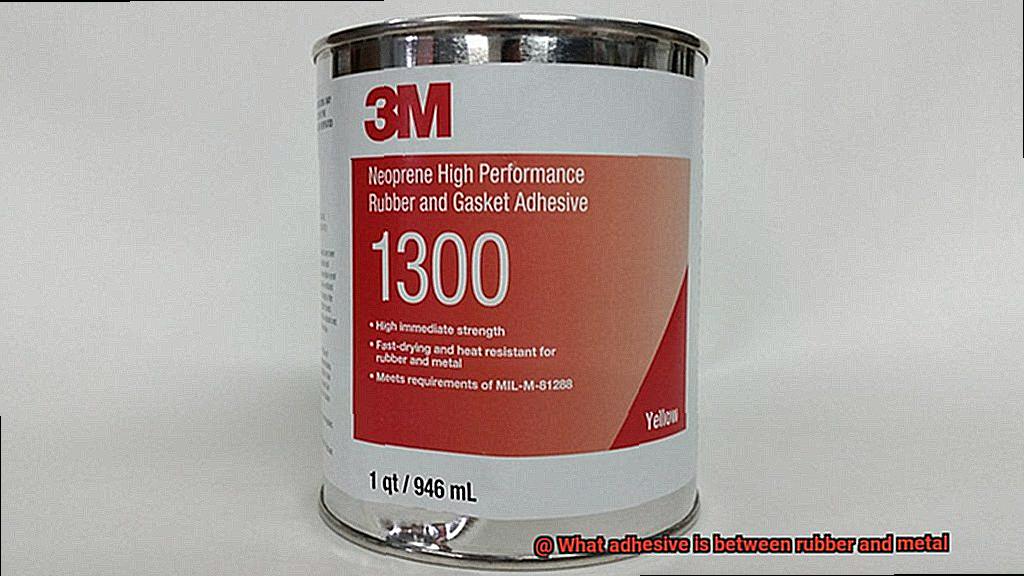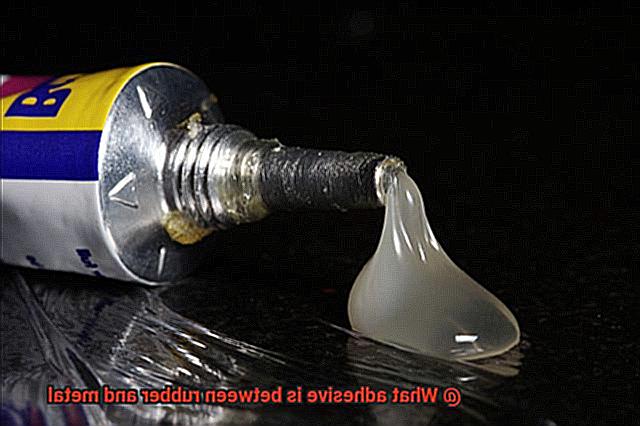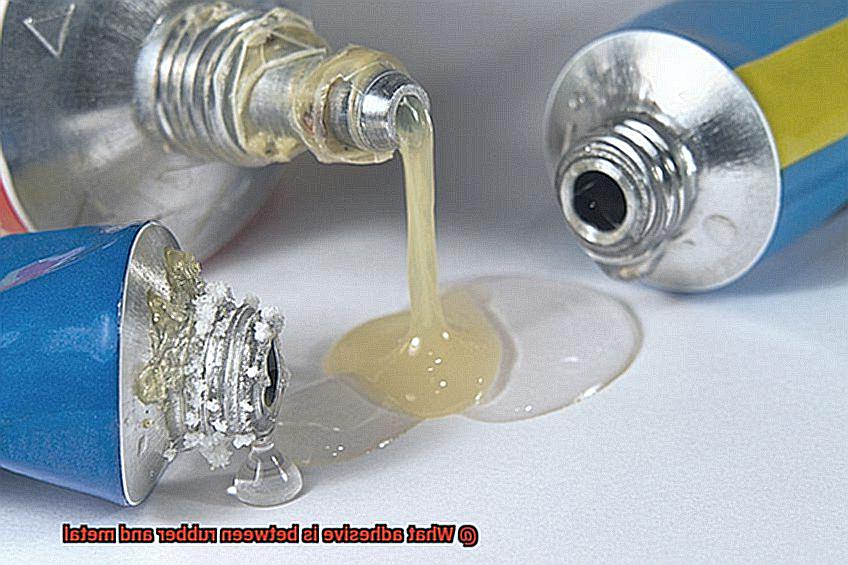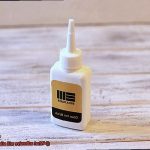Welcome to our blog post all about the magical world of rubber-to-metal adhesion.
If you’ve ever wondered how rubber manages to cling to metal, then this is the place for you. The secret behind this incredible bond lies in a special kind of adhesive called a rubber-to-metal adhesive.
This adhesive is specifically designed to create a tough and long-lasting connection between rubber and metal surfaces. Unlike regular adhesives that struggle with these different materials, rubber-to-metal adhesives have unique properties that make them the perfect choice for this job.
So, how does it work? Well, imagine the adhesive as a superhero glue that acts like a bridge, forming a strong chemical bond between the rubber and metal.
Join us as we take a deep dive into this fascinating topic and learn more about this extraordinary adhesive.
Types of Adhesives for Bonding Rubber to Metal
Contents
- 1 Types of Adhesives for Bonding Rubber to Metal
- 2 Two-Component Epoxy Adhesive
- 3 Cyanoacrylate Adhesive (Superglue)
- 4 Silicone-Based Adhesive
- 5 Specialized Adhesives for Rubber-to-Metal Bonding
- 6 Factors to Consider When Choosing an Adhesive
- 7 Benefits of Using the Right Adhesive
- 8 Common Applications for Rubber and Metal Bonding
- 9 Conclusion
Rubber and metal are two different materials that require a strong adhesive to bond them together. There are several types of adhesives available for this purpose, each with its own unique properties and applications.
Rubber Adhesive:
Rubber adhesive is specifically designed to bond rubber materials together or to other surfaces. It provides a strong and flexible bond, making it ideal for bonding rubber to metal. Rubber adhesives come in various forms, such as liquid adhesives, adhesive tapes, or adhesive sheets. The choice of form depends on the specific application and the desired level of convenience and ease of use.
Epoxy Adhesive:
Epoxy adhesives are known for their high strength and durability. They can provide a strong bond even in harsh conditions, such as exposure to heat, chemicals, or moisture. Epoxy adhesives typically consist of two parts – a resin and a hardener – that need to be mixed together before application. Once mixed, the epoxy adhesive is applied to the surfaces to be bonded and allowed to cure. During the curing process, the adhesive hardens and forms a strong bond between the rubber and metal.
Cyanoacrylate Adhesive:
Cyanoacrylate adhesives, also known as super glues or instant adhesives, are another option for bonding rubber to metal. These adhesives are known for their fast curing time and strong bond strength. They work by polymerizing quickly upon contact with moisture, creating a tight bond between the rubber and metal surfaces. However, they may not offer the same level of durability and resistance as epoxy adhesives.
Silicone Adhesive:
Silicone-based adhesives are often preferred when flexibility and vibration resistance are important. Silicone adhesives can withstand a wide range of temperatures and provide good resistance to moisture and UV radiation. They can be particularly suitable for applications where rubber parts need to be bonded to metal surfaces that undergo frequent movement or flexing.
Specialty Adhesives:
Some applications may require specialized adhesives designed specifically for rubber-to-metal bonding. These adhesives are formulated to have excellent adhesion to both rubber and metal surfaces, ensuring a strong bond. They may also offer additional benefits such as resistance to oils, fuels, or other chemicals commonly encountered in specific industries or environments.
When selecting an adhesive for bonding rubber to metal, it is important to consider factors such as the specific materials being bonded, the environmental conditions the bond will be exposed to, and the required bond strength. Consulting with adhesive manufacturers or experts can help determine the most suitable adhesive for a particular application.
Two-Component Epoxy Adhesive
Two-component epoxy adhesive is a versatile and reliable solution for bonding rubber and metal surfaces. It offers a range of benefits that make it an excellent choice for various applications. Here are some key advantages:
- Exceptional adhesion: Two-component epoxy adhesives are known for their excellent adhesion properties. They form strong chemical bonds with both rubber and metal surfaces, creating a durable and long-lasting bond. This ensures that the bonded parts stay securely in place even under heavy loads or stress.
- High strength: These adhesives are designed to provide high strength, ensuring that the bond between rubber and metal is secure. This is particularly important in applications where the bonded parts may be subjected to heavy loads or stress. The adhesive can withstand the forces exerted on the bond, preventing any separation or failure.
- Resistance to heat, chemicals, and moisture: Two-component epoxy adhesives offer excellent resistance to heat, chemicals, and moisture. This makes them suitable for a wide range of environments and applications. Whether it’s a hot and humid environment or exposure to corrosive substances, the adhesive maintains its integrity and keeps the bond intact.
- Flexibility: Rubber has inherent flexibility, which can pose challenges when bonding it with rigid metal surfaces. However, certain two-component epoxy adhesives are specifically formulated to have some degree of flexibility. This allows for movement between the rubber and metal, preventing the bond from becoming brittle or breaking under stress. The adhesive accommodates the natural movement of the materials, ensuring a long-lasting bond.
- Easy application: Two-component epoxy adhesives are easy to apply using a brush or a dispenser. They come as separate resin and hardener components that need to be mixed together before application. Once mixed, the adhesive can be easily applied to the surfaces and allowed to cure. This simplifies the bonding process and ensures a proper bond formation.
- Versatility: Two-component epoxy adhesives are compatible with different types of rubber and metal materials. However, it is important to choose an adhesive that is suitable for the specific materials being bonded. Some adhesives are designed for specific types of rubber or metal, so it is essential to follow the manufacturer’s instructions and recommendations. The versatility of these adhesives allows for a wide range of applications in industries such as automotive, construction, and electronics.

Cyanoacrylate Adhesive (Superglue)

Cyanoacrylate adhesive, also known as superglue, is a powerful bonding agent that is commonly used to join rubber and metal surfaces. This adhesive offers numerous advantages, including its quick bonding time, strength, and versatility.
One of the primary benefits of cyanoacrylate adhesive is its rapid bonding time. When applied to clean and dry surfaces, it begins to bond within seconds, providing an almost instant adhesion between rubber and metal. This is particularly advantageous for projects that require immediate results or quick repairs.
Cyanoacrylate adhesive also boasts exceptional strength and durability. Once fully cured, it forms a tough and resilient bond that can withstand various stresses and strains. This is crucial when bonding rubber to metal, as the joint may experience bending, twisting, or vibration. With cyanoacrylate adhesive, you can rest assured that the bond will hold up well under these conditions.
Furthermore, this adhesive is highly versatile. It can effectively bond a wide range of rubber types, including natural rubber, synthetic rubber, and silicone rubber, as well as various metals such as steel, aluminum, and brass. This versatility makes cyanoacrylate adhesive a go-to choice for applications where rubber needs to be securely attached to metal.
To achieve a strong bond between rubber and metal using cyanoacrylate adhesive, proper surface preparation is crucial. Both the rubber and metal surfaces should be clean, dry, and free from any contaminants such as oil, grease, or dust. To enhance the adhesive’s grip, slightly roughening the surfaces with sandpaper or a wire brush can be beneficial.
When applying the adhesive, it is important to use a thin and even layer on both surfaces. Applying too much adhesive can result in excess squeeze-out and weaken the bond. Pressing the rubber and metal surfaces firmly together immediately after applying the adhesive helps ensure maximum contact and bonding.
It is worth noting that not all cyanoacrylate adhesives are suitable for bonding rubber to metal. Some formulations may not provide sufficient adhesion or may not be compatible with certain types of rubber or metal surfaces. Therefore, it is important to select a cyanoacrylate adhesive specifically designed for this purpose. These specialized formulations often have enhanced bonding properties and are better suited for bonding rubber to metal.
Silicone-Based Adhesive
Silicone-based adhesive is the ultimate solution for bonding rubber and metal surfaces. It’s like a Swiss Army knife, versatile and reliable, capable of tackling a wide range of applications with ease.
First and foremost, silicone-based adhesive offers strong adhesion. It forms a sturdy bond between rubber and metal surfaces, ensuring a connection that won’t easily break. No matter the stress or load, this adhesive won’t let you down.
Flexibility is another key advantage. Silicone-based adhesive is elastic, able to withstand movements and vibrations without compromising its bond strength. It adapts to the natural flexibility of rubber, providing a long-lasting bond that can withstand even the toughest conditions.
But its versatility doesn’t stop there. Silicone-based adhesives can also bond other materials such as plastics, glass, ceramics, and fabrics. This makes them suitable for various industries, from automotive to construction, electronics to medical. Whatever your application may be, silicone-based adhesive has got you covered.
When it comes to extreme temperatures, silicone-based adhesive is a champion. It can handle scorching heat or freezing cold without losing its bond strength. This adhesive is built to withstand the harshest environments and keep your rubber and metal surfaces securely bonded.
Not only is silicone-based adhesive temperature-resistant, but it’s also resistant to moisture, chemicals, and UV radiation. This makes it perfect for outdoor applications or environments where exposure to water or chemicals is likely. Rest assured that your bond will stay intact, no matter what challenges come its way.
Now let’s talk about the application process. Before applying the silicone-based adhesive, it’s crucial to prepare the surfaces properly. Thoroughly clean them to remove any dirt, oil, or contaminants that could affect adhesion. Additionally, lightly roughen the metal surface using sandpaper or a similar abrasive material to enhance bonding strength.
Applying the adhesive is simple. Use a brush, roller, or squeeze tube to apply it evenly to one surface, ensuring full coverage. Then, press the two surfaces together firmly to create a strong bond. Remember to allow sufficient curing time for the adhesive to fully bond before subjecting the bonded assembly to any stress or load.
Specialized Adhesives for Rubber-to-Metal Bonding
When it comes to rubber-to-metal bonding, there are several specialized adhesives that can get the job done. Let’s take a closer look at some of the most commonly used types and their unique properties.
- Contact Adhesives: These solvent-based adhesives offer instant adhesion when the rubber and metal surfaces are pressed together. They provide excellent initial bond strength and are resistant to heat, moisture, and chemicals. If you need a quick and reliable bond, contact adhesives are a great choice.
- Two-Component Epoxy Adhesives: Epoxy adhesives consist of a resin and a hardener that need to be mixed together before application. These adhesives are known for their exceptional bonding strength and resistance to high temperatures, chemicals, and environmental factors. If you require a strong and durable bond that can withstand harsh conditions, two-component epoxy adhesives are the way to go.
- Polyurethane Adhesives: If you need some flexibility in your rubber-to-metal bond, polyurethane adhesives are a top pick. These adhesives offer good elasticity, allowing for some movement between the bonded surfaces without compromising bond strength. They are also highly durable and resistant to impact, vibration, and aging.
- Rubber-Specific Adhesives: Certain types of rubber, such as silicone rubber or EPDM rubber, require specialized adhesives for optimal bonding. These adhesives have unique formulations that ensure compatibility with the specific type of rubber being bonded. So, if you’re working with a specific type of rubber, make sure to choose an adhesive designed specifically for it.
When selecting an adhesive for rubber-to-metal bonding, it’s important to consider factors such as temperature resistance, flexibility, chemical resistance, and environmental conditions. Silicone-based adhesives, for example, offer excellent versatility and can bond various materials in addition to rubber and metal. They are highly resistant to extreme conditions, making them suitable for a wide range of applications. However, other adhesive types may be more suitable depending on your specific requirements.
Factors to Consider When Choosing an Adhesive
When it comes to choosing an adhesive for bonding rubber and metal surfaces, several factors must be taken into consideration. These factors will help ensure that you select the right adhesive for your specific application, providing a strong and long-lasting bond.
- Substrate Compatibility: It is crucial to choose an adhesive that is specifically formulated for bonding rubber and metal. Not all adhesives are created equal, and some may not provide the same level of adhesion to both materials. By selecting an adhesive that is compatible with both rubber and metal surfaces, you can ensure a strong bond.
- Strength and Durability: Consider the specific demands of your application. Will the bonded assembly be exposed to temperature variations, chemicals, moisture, or mechanical stress? Choose an adhesive that can withstand these conditions and provide a durable bond between rubber and metal.
- Flexibility: Rubber materials have a certain degree of flexibility or elasticity. It is essential to select an adhesive that can accommodate this characteristic to prevent cracks or delamination in the bond. A flexible adhesive will allow for any movement or expansion that may occur between the rubber and metal surfaces.
- Cure Time: Depending on your application requirements, you may need an adhesive with a fast cure time or one that allows for extended working time. Fast-curing adhesives are beneficial in production environments where quick assembly is necessary. On the other hand, longer cure times may be needed for applications that require precise positioning or adjustment.
- Environmental Considerations: Consider the operating environment of the bonded assembly. Will it be exposed to temperature extremes, UV radiation, humidity, or chemicals? Select an adhesive that can withstand these environmental factors and maintain its bond strength over time.
- Application Method: Evaluate the available equipment and resources for applying the adhesive. Different adhesives may require specific application techniques such as spraying, brushing, or dispensing through a nozzle. Choose an adhesive that aligns with your capabilities and production requirements.
- Cost: While cost should not be the sole determining factor, it is important to consider the cost-effectiveness of the adhesive. Strike a balance between performance and cost to ensure value for your application.
Benefits of Using the Right Adhesive
The benefits of using the right adhesive for a project are numerous and can greatly impact the performance, durability, and cost-effectiveness of the final product. Whether it’s bonding rubber and metal surfaces or any other materials, selecting the appropriate adhesive is crucial. Here are some of the key advantages:
Enhanced Bonding Strength: The right adhesive creates a strong and reliable bond between different surfaces, ensuring they stay securely attached even under extreme conditions or heavy loads. This is particularly important in applications where the joint needs to withstand stress or movement.
Improved Resistance to Temperature and Environmental Factors: Different adhesives offer varying levels of resistance to heat, cold, moisture, and chemicals. By choosing an adhesive specifically designed for the intended application, you can ensure that the bond remains intact and functional even in harsh environments.
- Prevention of Corrosion: Moisture can seep into joints between different materials, leading to corrosion over time. However, certain adhesives are formulated with anti-corrosive properties that create a protective barrier, preventing any damage or degradation.
- Increased Durability and Longevity: Adhesives with high resistance to wear and tear ensure that the bond remains strong even with repeated use or exposure to mechanical stress. This is particularly beneficial in applications where the components undergo frequent movement or vibration.
- Improved Aesthetics: Some adhesives are transparent or colorless, making them virtually invisible once applied between surfaces. This is advantageous in applications where visual appearance is important, such as in consumer products or automotive manufacturing.
- Simplified Manufacturing Process: Adhesives that offer fast curing times or require minimal surface preparation streamline production processes and reduce downtime. This increases efficiency and cost savings for manufacturers.
Common Applications for Rubber and Metal Bonding
Rubber and metal bonding is a fascinating and essential process that finds its applications in various industries. Let’s dive into some of the common uses for this bonding technique:
- Automotive industry: Rubber seals and gaskets are bonded to metal surfaces, creating a secure barrier against moisture, dust, and contaminants. This ensures the longevity of the vehicle’s interior and protects sensitive components from damage.
- Industrial machinery and equipment: Rubber mounts, pads, and isolators are bonded to metal frames or structures, minimizing vibrations and noise. This helps maintain a smooth and efficient operation while reducing wear and tear on the machinery.
- Electronics industry: Rubber-to-metal bonding attaches components like keypads, grommets, and insulators to metal surfaces in smartphones and appliances. The adhesive used withstands temperature fluctuations, provides electrical insulation, and maintains a strong bond even with repeated use.
- Footwear manufacturing: Adhesives secure rubber outsoles to metal shanks or plates in footwear, providing stability, support, and durability. These adhesives need to be flexible, resistant to moisture and heat, and capable of withstanding rigorous demands.
- Aerospace industry: Rubber seals, gaskets, and vibration dampers are bonded to metal components in aircraft engines, landing gear systems, and cabin interiors. The adhesive used must meet stringent safety standards as it plays a critical role in maintaining structural integrity.
- Medical devices: Rubber components are often bonded to metal frames or structures in prosthetics or orthopedic supports. The adhesive used must be biocompatible, resistant to bodily fluids, and capable of withstanding sterilization processes.
jzhXmioKTa4″ >
Conclusion
Rubber meets metal – a challenging combination that requires the perfect adhesive to create a lasting bond. Enter epoxy – the superhero of adhesives. With its exceptional bonding properties, epoxy is widely used in joining rubber and metal surfaces together. This dynamic duo consists of two components: resin and hardener. When combined, they form an unstoppable force that can conquer any material mismatch.
But wait. There’s another contender in this battle – cyanoacrylate adhesive, better known as super glue. Its lightning-fast action instantly fuses rubber with metal surfaces. However, it may not possess the same durability or resistance against harsh elements compared to its epoxy counterpart.
Choosing between these adhesive warriors depends on your project’s needs. Do you require a bond that can withstand extreme temperatures and moisture? Look no further than epoxy. Need a quick fix for a temporary connection? Super glue might be the hero you seek.
When in doubt, seek guidance from adhesive manufacturers or experts. They possess the wisdom to help you select the perfect adhesive sidekick for your rubber-to-metal bonding quest.






